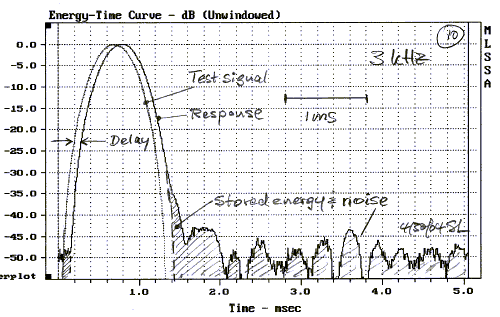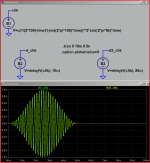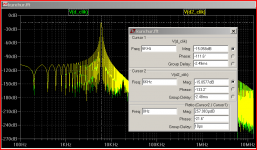I've been using the Dayton Omnimic for comparing raw drivers for some time now but time domain tests have always been pretty tough to understand for me. I'm going to start with what I think I understand and end with what I clearly don't quite get yet. 
If we start by identifying dimensions of interest:
1.amplitude
2.frequency
3.time
Distortion can therefore arise when the amplitude by frequency relationship is violated. This we classify as:
IMD and
MTD for complex signals and
HD for single tone systems.
The Omnimic can do HD up to 5th order.
Holding the frequency fixed, amplitude by time distortion can be defined as:
Delay
Decay
non-ideal reverb?
The combination of all three dimensions can depict the true signal, and the reproduced signal in its entirety. Any distortion produced is along one, two, but in reality all three dimensions. An example:
true signal is two tone 50hz, and 70hz of 90db amplitude each that start at time t and end at time t+s.
distorted signal takes the form of the speaker producing 100hz as well 140hz tones on top of the originals, the 70hz tone is reproduced at only 80db, both new tones produced start at time t+z and end at time t+z+s+r and so forth.
I'm fairly confident we have some decent tools for amplitude and frequency distortion of many types, but where are the tests for the time domain? How important are they? If cumulative spectrum decay plots (that depict all three dimensions) store the same information as frequency response plots does that mean we can compress the problem to only two dimensions?
If we start by identifying dimensions of interest:
1.amplitude
2.frequency
3.time
Distortion can therefore arise when the amplitude by frequency relationship is violated. This we classify as:
IMD and
MTD for complex signals and
HD for single tone systems.
The Omnimic can do HD up to 5th order.
Holding the frequency fixed, amplitude by time distortion can be defined as:
Delay
Decay
non-ideal reverb?
The combination of all three dimensions can depict the true signal, and the reproduced signal in its entirety. Any distortion produced is along one, two, but in reality all three dimensions. An example:
true signal is two tone 50hz, and 70hz of 90db amplitude each that start at time t and end at time t+s.
distorted signal takes the form of the speaker producing 100hz as well 140hz tones on top of the originals, the 70hz tone is reproduced at only 80db, both new tones produced start at time t+z and end at time t+z+s+r and so forth.
I'm fairly confident we have some decent tools for amplitude and frequency distortion of many types, but where are the tests for the time domain? How important are they? If cumulative spectrum decay plots (that depict all three dimensions) store the same information as frequency response plots does that mean we can compress the problem to only two dimensions?
It's a two dimensional problem at each point in space where the measurements are taken. Frequency and time are both related by the Fourier transform- know one and you know the other. This is well known stuff for almost 200 years.
The interesting problem with transducers is the "at each point in space" bit.
The interesting problem with transducers is the "at each point in space" bit.
Ahh, very interesting. By the Fourier transform we then have a deterministic relationship and the three dimensions I have referred to can in fact be compressed down to two.
The "at each point in space" bit I take to mean I'm actually missing a fourth dimension. If I understand this correctly I can extend my example to say distortion can also arise if the 50hz tone is 90db only on the loveseat, while it is 80db on the couch and therefore we introduce a concept like beaming while also making the assumption that omnidirectional sound is ideal.
The "at each point in space" bit I take to mean I'm actually missing a fourth dimension. If I understand this correctly I can extend my example to say distortion can also arise if the 50hz tone is 90db only on the loveseat, while it is 80db on the couch and therefore we introduce a concept like beaming while also making the assumption that omnidirectional sound is ideal.
Omnidirectional is not an assumed ideal- there are a lot of schools of thought about dispersion patterns, and lots of threads here discussing (heatedly!) that issue. In a sense, this is a six dimensional problem (time+amplitude or frequency+amplitude multiplied by three spatial dimensions), but that assumes point source detection, which is not the case for ears.
In real-world measurements, the issue when transforming impulse response to amplitude frequency, phase frequency response, decay etc. is a dynamic range. It is very limited by noise (background noise or whatever) in case of single impulse, little better situation is for MLSA derived impulse response. Swept sine is still best in resolution.
In pure maths, everything can be calculated from impulse response, except for non-linear behavior.
It would be great to have a transient recorder with 20bit/10Ms/s capability. Audio signals seem to be limited at 20 kHz (which is not true), but limit of ear ITD resolution is about 2 - 5 us.
In pure maths, everything can be calculated from impulse response, except for non-linear behavior.
It would be great to have a transient recorder with 20bit/10Ms/s capability. Audio signals seem to be limited at 20 kHz (which is not true), but limit of ear ITD resolution is about 2 - 5 us.
Omnidirectional is not an assumed ideal- there are a lot of schools of thought about dispersion patterns, and lots of threads here discussing (heatedly!) that issue. In a sense, this is a six dimensional problem (time+amplitude or frequency+amplitude multiplied by three spatial dimensions), but that assumes point source detection, which is not the case for ears.
Most definitely, I merely assumed omni was desired in calling anything but it "distortion." I take dispersion choice to be more of a subjective choice.
In real-world measurements, the issue when transforming impulse response to amplitude frequency, phase frequency response, decay etc. is a dynamic range. It is very limited by noise (background noise or whatever) in case of single impulse, little better situation is for MLSA derived impulse response. Swept sine is still best in resolution.
In pure maths, everything can be calculated from impulse response, except for non-linear behavior.
It would be great to have a transient recorder with 20bit/10Ms/s capability. Audio signals seem to be limited at 20 kHz (which is not true), but limit of ear ITD resolution is about 2 - 5 us.
Ok so the first bit was about signal to noise ratio? I regularly put on some plugs and test my gear in excess of 100db with swept sines.
Non-linear behavior as in HD right?
I never played with a transient recorder. Would this be equivalent to overlapping impulse responses in an effort to time align multi-way speakers?
Background noise is the limit in any measurement, unless you are determined to only use 1968 technology. It's very easy to get high resolution low noise data in 2012, even with impulses. MLS gives a huge advantage, but then you have the issue of people grumbling at you about nonexistent problems with "averaging," despite the virtues of autocorrelation.
I take dispersion choice to be more of a subjective choice.
Precisely. That's where the "art" of loudspeaker design comes into play.
I think this is something worth investigating.It would be great to have a transient recorder with 20bit/10Ms/s capability. Audio signals seem to be limited at 20 kHz (which is not true), but limit of ear ITD resolution is about 2 - 5 us.
I've been wanting to open a similar thread but refrained to do so because I though the interest would be very limited.
I've seen few attempts to do time-domain measurements when harmonic distortion is very low in an attempt to correlate subjective sound differences with objective data. unfortunately no such work I know about seems credible enough. a rather well-known "study" was the one by Nordost where they attempted to prove that cables and other treatments make a measurable difference. unfortunately that was so obviously filled with marketing and dubious claims that it wasn't well received (for good reason, IMO).
I really wish someone tried to do measurements of that kind in a credible fashion.
it would be interesting to read some control theory (not necessarily applied to audio) that focuses on time-domain analysis.
I apologize ahead of time for lingering on this 200 year old subject but I still have a lot of details to iron out.
Consider this picture from Linkwitz's site:

Since the time domain can be collapsed somehow then all this time information for each frequency should be available in a frequency response plot correct? So how do I back out what the delay and energy storage is for various frequencies of a speaker using the FR plot?
Consider this picture from Linkwitz's site:

Since the time domain can be collapsed somehow then all this time information for each frequency should be available in a frequency response plot correct? So how do I back out what the delay and energy storage is for various frequencies of a speaker using the FR plot?
the Fourier domain is fine too – the “amplitude only” restriction is a strawman tactic for use in Sophmoric arguments
“The Fourier Transform” of a time series contains both amplitude and phase info – using single complex number values for each frequency bin
the intra aural uS time domain resolution results say nothing about hearing beyond 20 kHz
the test signals are all “in band” - enveloped sine bursts of << 20 kHz
the sim below show the spectrum of such a burst signal, its frequency content falls over 100 dB by 20 kHz – practically no “information” is conveyed above 20 kHz
I delayed the raised sine enveloped 6 kHz by 10 us – you can read the delay from the fft plot cursors (both @ 6 kHz) calculate it yourself from the 6 kHz, 21.6 degree phase difference
no "100 kHz" info used in the calculation - no evidence any gets to our our brain via our ears
“The Fourier Transform” of a time series contains both amplitude and phase info – using single complex number values for each frequency bin
the intra aural uS time domain resolution results say nothing about hearing beyond 20 kHz
the test signals are all “in band” - enveloped sine bursts of << 20 kHz
the sim below show the spectrum of such a burst signal, its frequency content falls over 100 dB by 20 kHz – practically no “information” is conveyed above 20 kHz
I delayed the raised sine enveloped 6 kHz by 10 us – you can read the delay from the fft plot cursors (both @ 6 kHz) calculate it yourself from the 6 kHz, 21.6 degree phase difference
no "100 kHz" info used in the calculation - no evidence any gets to our our brain via our ears
Attachments
Last edited:
I may be wrong, but my guess is that the OP does not have sufficient foundation in maths and physics to understand his own questions. 'Time domain' and 'frequency domain' have meanings, connected via Fourier theory. I am not familiar with the American school system but I would guess that 5th grade does not cover orthonormal basis functions on inner product spaces, which is the foundation of Fourier?
1st year undergrad for physics and physical chemistry majors. The concept of complete orthonormal basis sets was covered in Chem 101, then Math 102 was where we first saw Fourier expansions and decompositions.
I didn't finish high school so perhaps some of this was covered earlier as well.
I didn't finish high school so perhaps some of this was covered earlier as well.
I'm not an engineer or a physicist...this is a hobby for me. Nonetheless, I regularly have to explain my research to specialists in other industries. Presenting to a wider audience is basic requirement in many fields is it not?
I've studied in both European and American (U.S.) institutions. In the E.U. the general consensus seems to be that everyone must have a rather elevated general knowledge tool set. In the U.S. the contribution to society comes first, general know-how far second. I find the U.S. model is a key ingredient to U.S.'s success. Snookie may not know how to read but she certainly has a show with global appeal. If she did take the time to learn Fourier theory I doubt she would be the movie star, and therefore the massive GDP contributing export that she is.
1. at least some of you should be able to explain the Fourier mapping in a different way. To some degree the ability to teach reflects your own grasp of the subject matter.
2. If I took a simple random sample of the population (U.S., E.U., or the world), or even the undergraduate, or graduate subsamples the share of those who know the Fourier transform would be negligible. I know this because the majority cannot take a derivative. However, I don't see this as a failure of the education system. Specialization is key.
If I get 5 explanations of the Fourier transform, they are all alike, and equally incomprehensible to someone that does not know it already, I might be considering it a failure on your part.
I've studied in both European and American (U.S.) institutions. In the E.U. the general consensus seems to be that everyone must have a rather elevated general knowledge tool set. In the U.S. the contribution to society comes first, general know-how far second. I find the U.S. model is a key ingredient to U.S.'s success. Snookie may not know how to read but she certainly has a show with global appeal. If she did take the time to learn Fourier theory I doubt she would be the movie star, and therefore the massive GDP contributing export that she is.
1. at least some of you should be able to explain the Fourier mapping in a different way. To some degree the ability to teach reflects your own grasp of the subject matter.
2. If I took a simple random sample of the population (U.S., E.U., or the world), or even the undergraduate, or graduate subsamples the share of those who know the Fourier transform would be negligible. I know this because the majority cannot take a derivative. However, I don't see this as a failure of the education system. Specialization is key.
If I get 5 explanations of the Fourier transform, they are all alike, and equally incomprehensible to someone that does not know it already, I might be considering it a failure on your part.
- Status
- This old topic is closed. If you want to reopen this topic, contact a moderator using the "Report Post" button.
- Home
- General Interest
- Everything Else
- Time domain distortion

